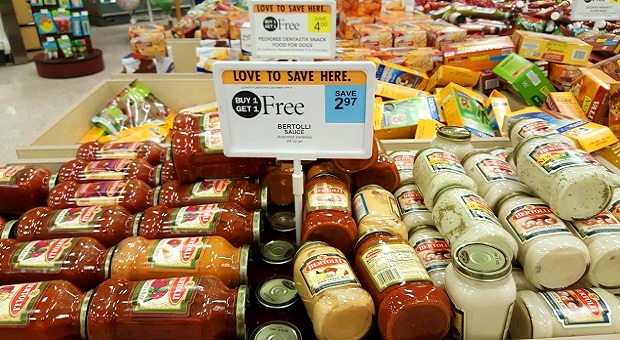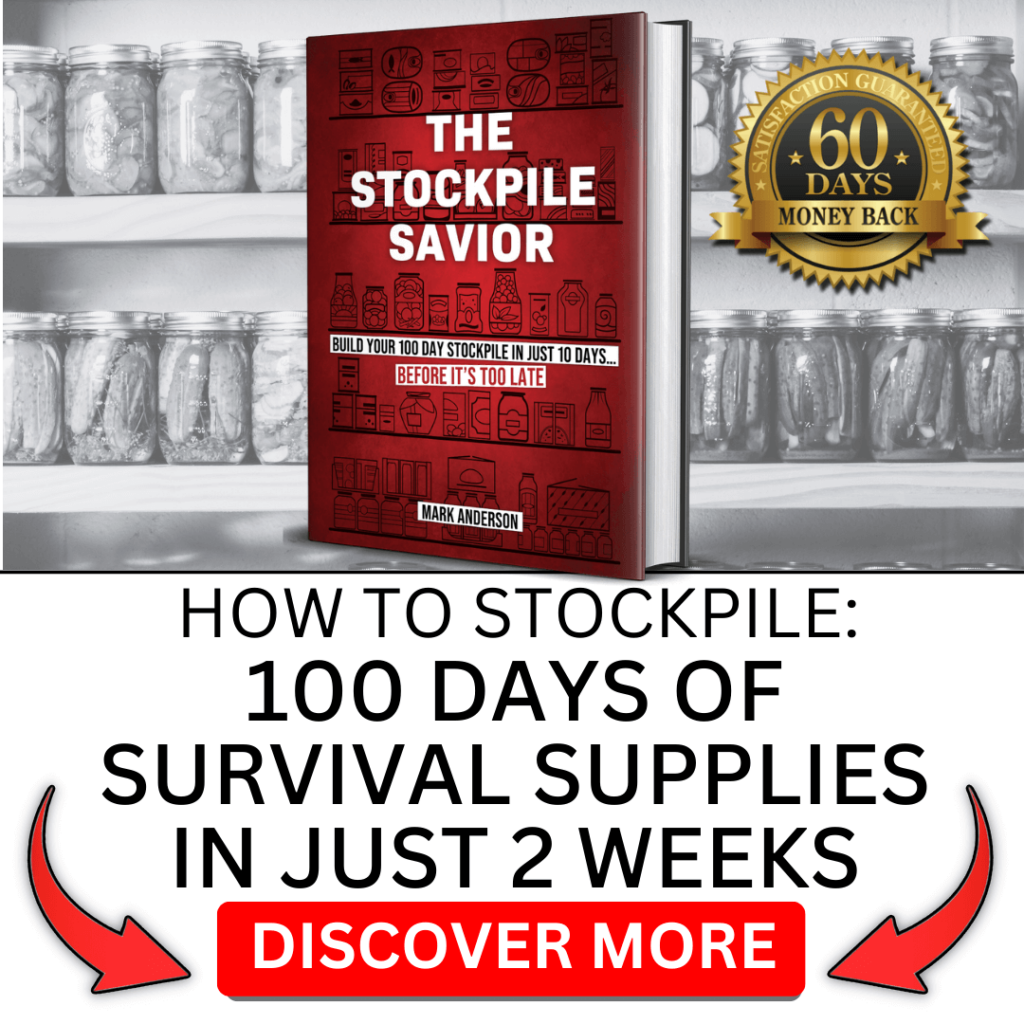Depending on where you live, summer heat can be miserable, but the dead of winter can be lethal. Good thing we have autumn between, which leaves us enough time to prepare for the harsh time of winter.
If there is a blizzard or downed powerlines, it may be tough to get to the store. Even if you do, the shelves may be bare. That’s why you need to stockpile for winter weeks ahead.
I’ve composed a list of must-have items that you should have on hand before the snow flies, in no particular order (except the first 4). But first, you should know how to calculate your reserves, so read this Survivopedia article to determine how much food and water would you need to survive in the worst case scenario.
Remember that stockpiling on a budget IS possible, if you know how to make the most out of coupons. We put up a list with useful tips and over 100 companies that you can ask for coupons from, when building your autumn reserve.
The List you Need to Have When Shopping
- Even if you’re surrounded by snow that you can melt if necessary, there’s no way to tell what’s in it. Plan on 2 gallons of water per person per day, and don’t forget about your pets.
- Two fuel sources, plus vehicle fuel. Make sure that your primary sources for warmth and cooking are well-stocked, and have a back-up fuel source for both. If the power goes out, you still have to cook and stay warm. A back-up supply is especially critical if you heat and cook with electric. If nothing else, keep extra Sterno cans.
- Back-up light sources. Even if you’re lucky enough to have solar panels, there may not be enough light to charge them. Candles and camp lanterns are two good choices. Make sure that if you’re using camp lanterns, you have plenty of batteries or fuel for them.
- First Aid Kit. If you’re like me, you probably pick through your first aid kit throughout the summer; a band aid here, some tape or first aid ointment there. Make sure that it’s replenished with fresh items before winter. Items such as tape actually go bad after a while.
- Pre-cooked canned meat. Tuna, chicken and salmon are all nutritious choices. Some of the canned hams are OK too, but avoid the unhealthy processed “meats” such as potted meat. If possible, can your own meat. Plan for at least 1 serving per person, per day. 2 servings are better.
- A variety of canned vegetables, preferably home-canned. Go by color because in general, different colors contain different nutrients. Eat at least 2 different colors per person per day. Plan on at least 4 servings per person, per day.
- A variety of canned fruits and dried fruits. Follow the same color rule as above and shoot for 2 servings per person, per day.
- A variety of canned meals. You can make can your own, or you can buy them in the store. Soups are great and are often BOGO at the grocery store if you watch the ads.
- Powdered milk and canned milk. Both have a long shelf life.
- Powdered eggs. Great source of protein and can be used in baking and cooking just like fresh eggs can once you reconstitute them.
- Whole grains have a longer shelf life than flour, but I’ve used flour that’s 2 years old and it was fine. If it goes rancid, it will smell funny. Store flour in air-tight containers or dry-can it so that bugs can’t get in.
- This is probably the cheapest, most versatile, longest-keeping food you can get. Stockpile whole-grain rice though, because it has a longer shelf life than instant.
- You can prepare cheese so that it will store for years and it’s a great source of protein. It’s also a luxury food that will help the kids eat veggies.
- Your body needs sodium, and it adds flavor to food.
- Sugar and honey. Honey literally keeps forever. Perfectly edible honey has been found in tombs that are thousands of years old. Even if it crystalizes, heat it a bit and it’s good as new.
- I prefer cubes, but powder is available, too. It turns a few mixed veggies and some canned beef or chicken into soup.
- A variety of spices. You can stock up on store-bought spices, dry your own, or even keep fresh spices growing indoors year round.
- Coffee or Tea along with filters. Seriously. Enough said.
- Peanut butter. It has a great shelf life as long as it’s unopened and is another good source of protein.
- Cooking oil and lard/shortening. Did you know you can actually can butter?
- Baking soda. A great multi-purpose item, useful for cooking, cleaning, and first aid.
- Again, multipurpose. I prefer apple cider vinegar because of the health benefits. You can make your own if you have apples.
- Active dry yeast packets. There’s nothing like fresh-baked bread. You can make your own yeast if need be.
- Baking powder and cream of tartar. Quick trick – if you don’t have baking powder, you can make it by combining 1/2 tsp. of cream of tartar and 1/4 tsp. baking soda to equal 1 tsp. of baking powder in a pinch.
- Dried beans. Amazingly nutritious and are available in such a variety and can be prepared in so many ways that they won’t get boring.
- Extra can opener. Ever tried to open a can without a can opener? It’s easier to just keep a backup or two.
- Hay and grain for livestock. If you’re an experienced farmer, you know this already, but if you’re just starting out, store enough hay for the winter now, and at least a few weeks’ worth of grain. Trust me: the price of hay skyrockets once the snow flies.
- Weather radio with extra batteries.
- Extra blankets or sleeping bags.
- Toilet paper. Being trapped in the house for a week or so due to a blizzard just isn’t the same without it.
- These have dozens of uses, so they’re not just for girls. There should be a few in your first aid kit, and they make excellent fire starters.
- Laundry soap.
- Hygiene items such as soap, lotion, toothpaste, etc.
- Lighters or matches. Hard to light a candle without one.
- Spare cash. If the power goes out, your ATM card will be useless and the banks will likely be closed.
- Pain medication such as ibuprofen, acetaminophen, or aspirin. Personally, I go with the ibuprofen because it’s an anti-inflammatory as well as a fever reducer and pain killer.
- Bleach.
- Alcohol that’s 70 proof or above has a variety of uses, including sterilizing needles or wounds, starting fires, and making merry when you’re stuck in the house. If you’re using it for the latter, see number 37.
- Baby wipes. They’re not just for babies.
- Peroxide.
- Extra equipment parts. Do you have a snowplow or tractor that you use to clear the driveway or to carry hay? Keep extra of the parts most likely to break.
- Garbage bags. If you need to leave the house, they keep the water and cold air out and the body heat in. They have several uses, so keep different sizes handy.
- Games, books and crafts. Board games, puzzles, puzzle books, and even Twister are good ways to kill time. Crayons, paper, scissors, coloring books (kids and adults), glue, and whatever else you need to perform your craft project(s) of choice.
- Rubbing Alcohol.
- Fire starters if you’re heating with wood.
- Fire-proof cookware if you’re using your grill or a fire as a backup cooking method.
- At least 1 5-gallon bucket with a lid. There are dozens of uses for them.
- Extra plywood, nails, and screws. If a window breaks during a storm, you can freeze to death quickly if you don’t get it sealed up. Plywood is also good for getting a car or tractor un-stuck.
- Rock salt. This keeps your walkway safe, but be careful. It melts the snow, but that water will refreeze again if the salt is washed away or absorbed into the ground.
- Duct tape. I through in an extra, because you always need duct tape.
This is a good list to use as a guideline but each situation is different. I’m sure that I’ve left off some important things, so if you have anything to add, please do so in the comments section below.












































































How do we keep our supplies, if FEMA will go house to house
Taking everything for human and animal? Please advise!k. Flynn
Buy a gun and do NOT be afraid to use it!
Thank you for your helpful posts. I get a lot of posts that lure you to a website that yaks and yaks and yaks and finally you find out just what they are trying to sell you. You always give us good info that is FREE!! keep up the good work!!
I voted 3 in error it should have been a 5 star, thank for the tips
Numbers 12, 16, 22, and 31 should have the item listed at the beginning. I understand what the items are, but if you are a newbie it would not be clear.
Nice list, and I also appreciate that it’s free.
#16, 22 and 31 could be explained more clearly. I’m thinking bouillon, vinegar and sanitary pads are what you are referencing though.
It’s great to tell people what to buy but just stocking up isn’t going to do it, especially with rice, beans, powdered milk and other dry goods. Bugs are already in the flour (eggs) and if you don’t freeze it for 4 days they will hatch out and you’ll open a container that looks like it has a black doughnut and stinks to high heaven! Ask me how I know. I lost 250lbs of rice, 100 lbs of flour, the beans are salvageable by tossing in a mesh strainer to get the bugs and eggs out and then sealing in Mylar with an O2 absorber. Milk….gone. Corn starch…gone. Etc… etc… And, as far as canned goods go, if you don’t have a temp controlled environment, you can lose them too! I have 2 words…. ROOT CELLAR!
Bleach! Perfect for those nights to make merry and have fun